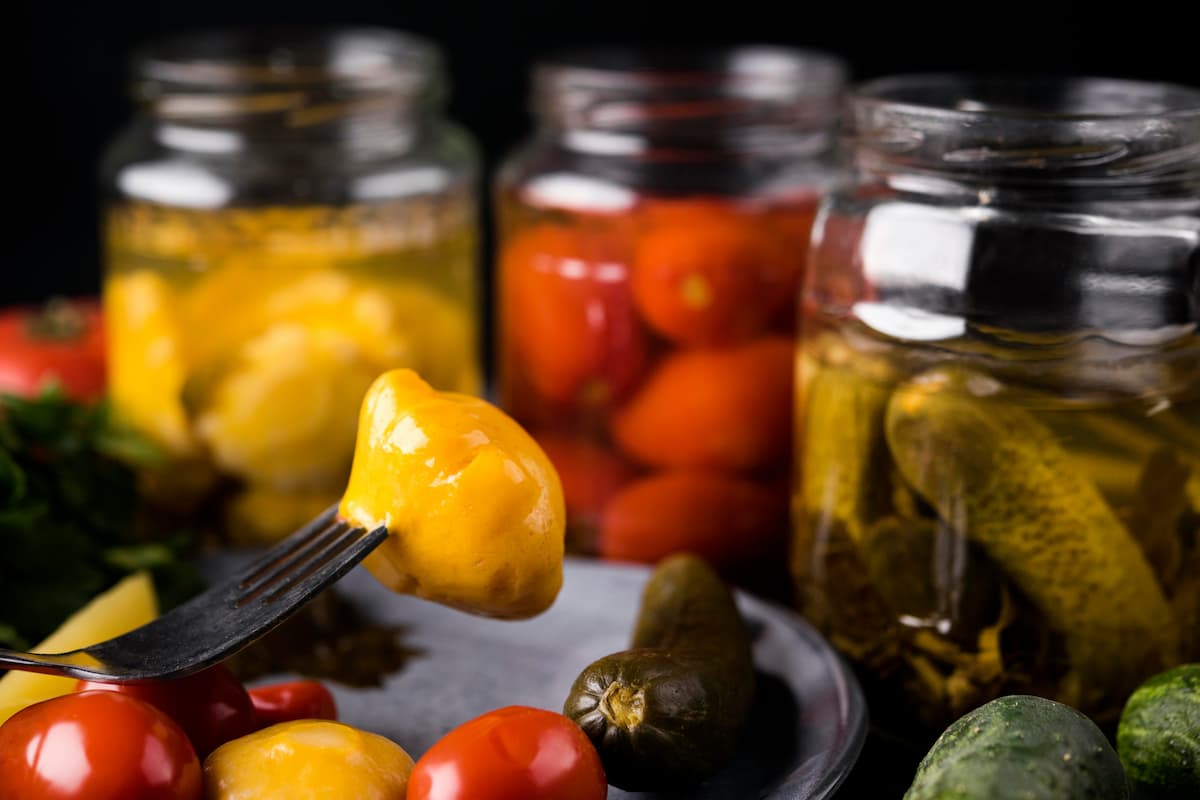Is Fermentation Anaerobic? Understanding the Process
Is Fermentation Anaerobic? This question is not only relevant but also crucial in understanding the process of fermentation and its impact on various articles and products. Fermentation plays a significant role in flavor enhancement, making it a subject of interest for both professionals and enthusiasts. From the world of gourmet cooking to the realm of health benefits, fermentation has been linked to a wide range of advantages. Articles and studies have highlighted how fermentation can elevate the flavors of everyday dishes, providing a burst of taste and aroma that captivates the senses. But what exactly happens during fermentation, and why is it important to create an anaerobic environment? The breakdown of sugars by microorganisms is a key component of this process, and it occurs in the absence of oxygen. By blocking oxygen from entering the jars, fermentation lids, such as the BurpLids® fermentation kit, help create the optimal conditions for this anaerobic fermentation. As we delve into the world of fermentation, we'll explore the connection between flavor enhancement and fermentation in various articles and products. Join us on this journey to unlock the secrets behind the captivating flavors that fermentation brings and discover how you can enhance your own culinary creations through this transformative process. So, is fermentation anaerobic? Let's find out!
What is Fermentation?

Fermentation is a fascinating biological process that plays a crucial role in various aspects of our lives. In simple terms, fermentation is the breakdown of sugars by microorganisms in the absence of oxygen. This process results in the production of energy and various byproducts, such as alcohol, lactic acid, and carbon dioxide.
Is Fermentation an Anaerobic Process?
Yes, fermentation is an anaerobic process . It occurs in the absence of oxygen, making it different from aerobic respiration, which requires oxygen. The microorganisms involved in fermentation do not require oxygen to carry out their metabolic activities. Instead, they rely on alternative pathways to break down sugars and generate energy.
The Importance of Anaerobic Conditions in Fermentation
Understanding the anaerobic nature of fermentation is crucial for anyone interested in the process, especially those looking to venture into the world of home fermentation. Anaerobic conditions are essential for the successful fermentation of foods and beverages. By creating an environment devoid of oxygen, fermentation can occur uninterrupted, allowing the microorganisms to carry out their metabolic activities and produce the desired flavors, textures, and preservation effects.
While the role of fermentation in culinary practices is clear, one might ask if it ties into larger biological processes. The answer lies in the curious relationship between fermentation and our body's energy cycles. In fact, is fermentation a part of cellular respiration? Absolutely. During intense exercise when oxygen is scarce, our muscle cells switch to fermentation to produce energy quickly. This remarkable adaptation is reflective of the same anaerobic conditions that are harnessed in food preservation and flavor enhancement.
The BurpLids® Fermentation Kit
To facilitate anaerobic fermentation, innovative products like the BurpLids® fermentation kit have been developed. These fermentation lids are designed to create an airtight seal on wide-mouth mason jars, effectively blocking oxygen from entering while allowing gases to escape. With a low-profile waterless airlock design and a no-burp valve, these lids eliminate the need for cumbersome water-filled airlocks and the daily burping of jars. The result? A hassle-free and efficient fermentation process.
Features of the BurpLids® Fermentation Kit
- Practical and suitable for both novice and experienced fermenters
- Made of high-quality BPA-free materials
- Easy to use, clean, and open
- Includes an extraction pump and fermentation weights for optimal fermentation conditions
- Compatible with all wide-mouth mason jars
- Provides the ideal environment for anaerobic fermentation
Fermentation is an anaerobic process that occurs when microorganisms break down sugars in the absence of oxygen. Understanding this concept is crucial for successful home fermentation and the production of flavorful and preserved foods and beverages. With the help of innovative products like the BurpLids® fermentation kit, creating an anaerobic environment for fermentation has never been easier. So, whether you're a seasoned fermenter or just starting out, harness the power of anaerobic fermentation with BurpLids® and unlock a world of delicious possibilities!
Anaerobic Respiration and Fermentation: A Comparison
Anaerobic respiration and fermentation are two processes that occur in the absence of oxygen and involve the breakdown of organic compounds to release energy. While they share similarities, they have distinct differences, particularly in their final electron acceptors.
Anaerobic Respiration
Anaerobic respiration is a process that occurs in some bacteria and archaea. It involves the breakdown of organic compounds, such as glucose, to release energy. However, unlike aerobic respiration which uses oxygen as the final electron acceptor, anaerobic respiration uses other molecules, such as nitrate or sulfate, as the final electron acceptor. This allows the microorganisms to generate energy in the absence of oxygen.
Fermentation
Fermentation, on the other hand, is a metabolic process that occurs in some microorganisms and in the muscle cells of animals during strenuous exercise. Like anaerobic respiration, fermentation also involves the breakdown of organic compounds to release energy. However, the final electron acceptor in fermentation is an organic molecule, such as pyruvate or acetaldehyde, rather than an inorganic molecule like oxygen. This allows the microorganisms or muscle cells to continue generating energy in the absence of oxygen.
Key Differences
- Energy Production: Anaerobic respiration is more efficient and produces a greater amount of energy compared to fermentation. This is because the final electron acceptors in anaerobic respiration have a higher energy yield than the organic molecules used in fermentation.
- Byproducts: In anaerobic respiration, the byproducts can vary depending on the final electron acceptor used. For example, when nitrate is used as the final electron acceptor, the byproduct is nitrite. In fermentation, the byproducts can include various organic compounds such as ethanol, lactic acid, or carbon dioxide.
Fermentation: Exploring the Types and Applications
Fermentation is a fascinating process that occurs in various food products, and it can be classified into different types based on the end products produced. In this section, we will explore the three main types of fermentation: lactic acid fermentation, alcohol fermentation, and acetic acid fermentation.
Lactic Acid Fermentation
Lactic acid fermentation occurs when pyruvate, a product of glycolysis, is converted into lactic acid. This type of fermentation is commonly found in food products like yogurt and sauerkraut.
- In yogurt production, specific strains of bacteria convert lactose, the sugar present in milk, into lactic acid. This process gives yogurt its tangy flavor and helps in preserving the product.
- Similarly, sauerkraut, a fermented cabbage dish, undergoes lactic acid fermentation, which not only enhances its taste but also extends its shelf life.
Alcohol Fermentation
Alcohol fermentation involves the conversion of pyruvate into ethanol and carbon dioxide. This process is widely used in the production of alcoholic beverages and bread-making.
- In the brewing industry, yeast is responsible for converting sugars in malted grains into alcohol and carbon dioxide, resulting in the formation of beer.
- In bread-making, yeast plays a vital role in leavening the dough, producing carbon dioxide gas, which creates the characteristic airy texture of bread.
Acetic Acid Fermentation
In acetic acid fermentation, ethanol is converted into acetic acid. This type of fermentation is particularly important in vinegar production.
- When alcoholic beverages, such as wine or cider, are exposed to oxygen and the right bacteria, acetic acid bacteria convert the ethanol into acetic acid. This process imparts the sour taste and distinctive aroma to vinegar, making it a versatile ingredient in cooking and preserving food.
Fermentation: Why is the Absence of Oxygen Important?
Fermentation is a fascinating process that has been used for centuries to create a variety of products, from bread and beer to yogurt and sauerkraut. One of the key aspects of fermentation is that it is considered an anaerobic process, meaning that it occurs in the absence of oxygen. But why is the absence of oxygen so important for fermentation to occur?
To understand this, let's take a closer look at how fermentation works. Fermentation is a metabolic process that occurs in the absence of oxygen and involves the breakdown of sugars by microorganisms, such as yeast or bacteria. These microorganisms convert the sugars into other compounds, such as alcohol, lactic acid, or carbon dioxide, depending on the specific type of fermentation.
When oxygen is present, microorganisms have the option to undergo aerobic respiration, which is a more efficient process for generating energy. However, in the absence of oxygen, they switch to fermentation as a way to continue producing energy. This is because fermentation allows them to generate energy without the need for oxygen.
The absence of oxygen is a key requirement for fermentation to occur because oxygen acts as a powerful electron acceptor in aerobic respiration. In the presence of oxygen, microorganisms can use oxygen as the final electron acceptor in the electron transport chain, which allows them to generate a large amount of energy. However, in the absence of oxygen, microorganisms need to find an alternative way to regenerate the electron carrier molecules that are used in the energy generation process.
This is where fermentation comes in. During fermentation, microorganisms use other electron acceptors, such as organic molecules, to regenerate the electron carrier molecules. This allows them to continue generating energy even in the absence of oxygen. The byproducts of fermentation, such as alcohol or lactic acid, are the result of the metabolic pathways that microorganisms use to regenerate the electron carrier molecules.
Analyzing the Common Headings for Fermentation
When analyzing the top search engine results for the topic of fermentation, several common headings emerge. By exploring these commonalities, we can gain a deeper understanding of the key aspects of fermentation and how it relates to the target audience.
Types of Fermentation
One common heading that frequently appears is "Types of Fermentation." This heading highlights the different processes involved in fermentation, such as lactic acid fermentation and alcohol fermentation .
- Lactic acid fermentation: This type of fermentation occurs in certain bacteria and human muscle cells. It is responsible for the production of lactic acid, which can be found in foods like yogurt and sauerkraut.
- Alcohol fermentation: This process is carried out by yeast and some bacteria. It involves the conversion of sugars into ethanol and carbon dioxide, resulting in the production of alcoholic beverages like beer and wine.
Anaerobic Respiration
Another common heading is "Anaerobic Respiration." This term refers to the process of obtaining energy from food without the presence of oxygen. Fermentation is a form of anaerobic respiration, as it allows microorganisms to break down sugars in the absence of oxygen. This process is essential for the production of various fermented foods and beverages.
Flavor Enhancement through Fermentation

Furthermore, the concept of flavor enhancement through fermentation is often mentioned in the top search results. Fermentation plays a crucial role in developing unique and complex flavors in foods and beverages. By allowing microorganisms to interact with the ingredients, fermentation creates a range of flavors that cannot be achieved through other methods of food preparation.
To support these main points, it is important to incorporate relevant information from reputable sources. For example, the Khan Academy article on fermentation and anaerobic respiration provides in-depth explanations of the different types of fermentation and their significance. Additionally, the BurpLids® website offers a fermentation kit that highlights the benefits of using their products, such as faster and more efficient curing and the elimination of the need to burp mason jar lids daily.
Exploring the common headings from the top search engine results allows us to delve into the key aspects of fermentation. By understanding the different types of fermentation, the process of anaerobic respiration, and the role of fermentation in flavor enhancement, we can gain a comprehensive view of this fascinating process. Incorporating relevant information from reputable sources further supports these main points and provides valuable insights for the target audience. So whether you're a seasoned fermenter or just starting out, fermentation offers a world of flavors and possibilities to explore!
Fermented Foods: A Gateway to Better Health
Fermentation has been a traditional practice for centuries, and it turns out that there are several potential health benefits associated with consuming fermented foods. These foods undergo a process where microorganisms break down sugars in the absence of oxygen, resulting in the production of beneficial compounds.
Promoting Gut Health
One of the key benefits of fermented foods is their ability to promote gut health. The fermentation process produces probiotics , which are beneficial bacteria that help maintain a healthy balance in our digestive system. These probiotics can help improve digestion, boost the immune system, and even alleviate symptoms of certain gastrointestinal conditions.
The Gut-Brain Connection
But did you know that the connection between gut health and brain health is also becoming increasingly apparent? Research suggests that there is a strong link between the two, and consuming fermented foods can have a positive impact on both. The gut is often referred to as our "second brain" because it houses a complex network of neurons that communicate with our actual brain. This connection is known as the gut-brain axis.
When our gut is healthy and populated with beneficial bacteria, it can have a positive impact on our mental well-being. Studies have shown that probiotics derived from fermented foods can help reduce symptoms of depression, anxiety, and stress. They may also improve cognitive function and memory. The exact mechanisms behind this connection are still being explored, but it is believed that the gut-brain axis plays a crucial role in regulating mood and mental health.
Other Health Benefits
In addition to promoting gut and brain health, fermented foods offer other potential health benefits. They are often rich in vitamins, minerals, and antioxidants, which can contribute to overall well-being. Fermented foods such as sauerkraut, kimchi, and yogurt are also known to support a healthy immune system. The beneficial bacteria in these foods help strengthen the body's defense against harmful pathogens.
Choosing the Right Fermented Foods
It's important to note that not all fermented foods are created equal, and the health benefits may vary depending on the specific food and fermentation process. To ensure you're getting the maximum benefits, it's important to choose high-quality, properly fermented foods.
The BurpLids® fermentation kit , for example, is designed to facilitate the anaerobic fermentation process by creating an airtight seal that blocks oxygen from entering the jars. This helps preserve the beneficial bacteria and ensures a successful fermentation. The kit also includes fermentation weights, which are used to keep the vegetables submerged in the brine, preventing spoilage and promoting even fermentation.
In the pursuit of perfecting the fermentation process, not only is the absence of oxygen critical, but so is temperature control. The ideal fermentation temperature plays a pivotal role in cultivating the right conditions for microorganisms to thrive and carry out fermentation effectively. For instance, a moderate temperature range that is neither too hot nor too cold can significantly enhance the rate of fermentation, leading to more robust flavors and improved textures in fermented foods.
Fermented foods offer a wide range of potential health benefits, from supporting gut health to improving brain function. By incorporating fermented foods into your diet, you can enjoy the delicious flavors while reaping the benefits of these probiotic-rich foods. Whether you're a seasoned fermenter or just starting out, the BurpLids® fermentation kit provides a convenient and effective way to enjoy the benefits of fermented foods at home. So why not give it a try and see how fermentation can enhance your health and well-being?
BurpLids® Fermentation Kit
One of the key products offered by BurpLids® is their fermentation kit. This kit has several benefits that make it a valuable tool for fermenters:
- Faster and more efficient curing: With the BurpLids® fermentation kit, there is no need for daily burping of mason jar lids. The lids are equipped with airlock vacuum-seal valve technology and quick release tabs, allowing gases to exit the jar while keeping oxygen and other contaminants out. This creates an ideal environment for fermentation.
- Fermentation weights: The fermentation kit also includes fermentation weights, which play a crucial role in the process. These weights are used to keep the veggies buried beneath the brine, ensuring that they are fully submerged and protected during fermentation.
- Extraction pump: The kit also comes with an extraction pump, making it easier to achieve successful curing.
These features make the BurpLids® fermentation kit a handy and finely made tool suitable for both novice and experienced fermenters.
Exploring the BurpLids® Fermentation Kit
To learn more about the BurpLids® fermentation kit and its benefits, you can visit our website and explore the provided reference URLs. Our website offers detailed information about the kit, including:
- Advanced vacuum seal technology
- Compatibility with all wide-mouth mason jars
- Creation of an anaerobic environment for fermentation by blocking oxygen from entering the jars
- Allowance of gases to exit, preventing pressure build-up during fermentation
Whether you are a beginner looking to start your fermentation journey or an experienced fermenter seeking to streamline the process, the BurpLids® fermentation kit offers a convenient and efficient solution. So why not give it a try and experience the benefits of faster and more efficient curing? Visit our website for more information and get started on your fermentation adventure today!
The Fascinating Process of Fermentation and Its Importance in Various Industries
In this blog post, we will explore the fascinating process of fermentation and its importance in various processes and industries. We will summarize the main points we discussed and emphasize the anaerobic nature of fermentation.
What is Fermentation?
Fermentation is an anaerobic process that occurs when microorganisms break down sugars in the absence of oxygen. This process is utilized in many industries, including food and beverage production, pharmaceuticals, and biofuel production.
The Benefits of Fermentation
One of the key benefits of fermentation is flavor enhancement. The breakdown of sugars during fermentation produces a variety of compounds that contribute to unique and complex flavors. This is why fermented foods and beverages often have a rich and distinct taste. Additionally, fermentation can also improve the nutritional value of certain foods by increasing the bioavailability of vitamins and minerals.
Fermentation in the Food and Beverage Industry
In the food and beverage industry, fermentation is a crucial step in the production of many beloved products. For example, wine and beer are made through the fermentation of grapes and grains, respectively. Fermentation is also responsible for the tangy flavor of yogurt and the bubbly goodness of kombucha. Without fermentation, these products would not exist in their current form.
Fermentation in the Pharmaceutical Industry
Beyond food and beverage production, fermentation plays a vital role in the pharmaceutical industry. Many antibiotics, such as penicillin, are produced through fermentation. By cultivating specific strains of microorganisms, scientists can harness their natural ability to produce compounds with medicinal properties. This process has revolutionized medicine and has saved countless lives.
Fermentation in Biofuel Production
In the field of biofuel production, fermentation is used to convert organic matter into bioethanol. This renewable fuel source is derived from plants such as corn and sugarcane. Through fermentation, the sugars present in these plants are transformed into ethanol, which can be used as an alternative to fossil fuels. This Fermentation process is not only environmentally friendly but also helps reduce our dependence on non-renewable energy sources.
In Conclusion
Fermentation is an anaerobic process that holds immense importance in various industries. It not only enhances flavors and improves the nutritional value of food but also plays a crucial role in the production of pharmaceuticals and biofuels. By understanding and harnessing the power of fermentation, we can continue to innovate and create a sustainable future. So, next time you enjoy a slice of bread or sip on a glass of wine, remember the fascinating process of fermentation that made it all possible!
Is Fermentation Anaerobic? Understanding the Process
Fermentation is indeed an anaerobic process that plays a crucial role in flavor enhancement, food preservation, and even potential health benefits.
The BurpLids® website offers a wealth of information on fermentation, including articles that highlight the connection between fermentation and flavor.
BurpLids® provides a fermentation kit that caters to the needs of both novice and experienced fermenters, with unique features such as vacuum-sealed lids, extraction pumps, and waterless airlock valve technology. Using BurpLids® can significantly speed up and simplify the fermentation process, eliminating the need for daily burping of mason jar lids and ensuring a successful cure.
The range of products and accessories available, such as the BurpLids® 12 Pack Curing Kit and the BurpLids® BudPack, further showcase the commitment to fermentation and flavor enhancement.
Fermented foods have been linked to various health benefits, including improved brain health and digestion. The connection between gut health and brain health is highlighted on the website, with articles discussing the potential benefits of fermented foods in fighting against Alzheimer's disease and memory loss.
The webpage titled "From Bland to Grand: Discover How Easy Fermenting at Home Can Skyrocket the Flavor of Your Everyday Dishes" emphasizes the advantages of fermenting food at home, such as enhanced flavor, improved digestive health, natural food preservation, and increased nutritional value.
To explore more about fermentation and its benefits, visit the our website and read our fermentation articles. You can also delve into the fascinating world of black garlic and its use in enhancing flavors in gourmet cooking by checking out the article titled "Shocking Confessions of a Celebrity Chef: The Forbidden Fermented Ingredient That's Been Secretly Enhancing Flavors in Five-Star Kitchens".
So, what are you waiting for? Take a leap into the world of fermentation and experience the incredible flavors and potential health benefits it offers. Visit the BurpLids® website now and unleash your culinary creativity!
CTA: Visit the BurpLids® website at www.burplids.com to explore fermentation-related articles and products, and discover how you can elevate the flavors of your dishes through the art of fermentation.
 Plastic BurpLids® Curing Kit
Plastic BurpLids® Curing Kit
 BurpLids® 12 Pack Curing Kit
BurpLids® 12 Pack Curing Kit
 BurpLids® 14 Pack Curing Kit
BurpLids® 14 Pack Curing Kit
 BurpLids® Pack Of 4 Fermentation Kit
BurpLids® Pack Of 4 Fermentation Kit





